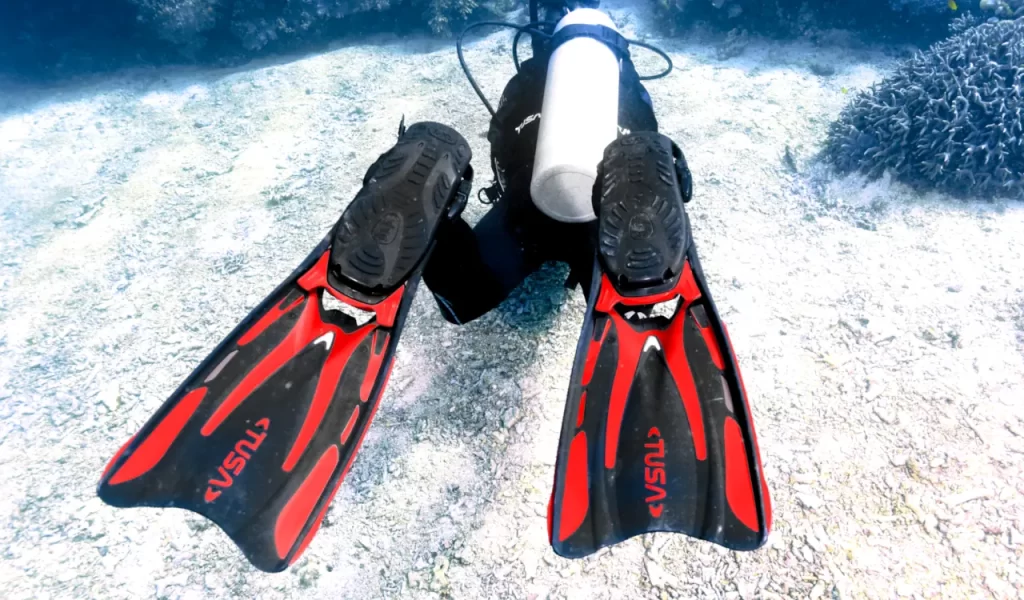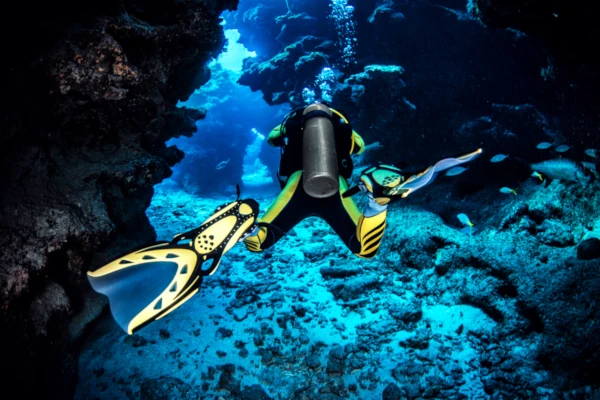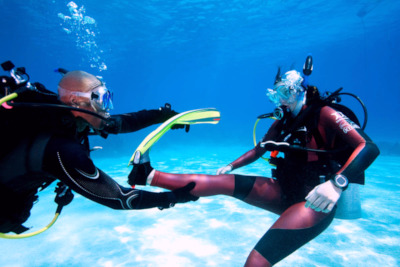Great Advanced Open Water Course Experience
PADI Advanced Open Water Diver Course The advanced open water diver course has 5 dive specialties to choose. Two are chosen for you, Deep and Navigation, the other three are…

Scuba diving finning techniques refer to the various ways divers use their fins to move and maneuver underwater. Mastering a range of finning styles is crucial for all levels of divers, from beginners to seasoned instructors. Using the appropriate kick for a given situation can greatly improve your underwater efficiency, reduce fatigue, and minimize disturbance to the environment. However, many entry-level scuba courses teach only a basic flutter kick, leaving divers unaware of alternative kicks that offer better control, precision, and adaptability.
This comprehensive guide provides an instructional yet detailed look at all the major finning techniques in use worldwide. We explain how each kick works, the best situations to use it, and the science behind it. By honing these skills, you will be able to propel yourself more effectively through the dense medium of water, conserve air through efficient movement, and protect both yourself and the underwater environment during your dives.
Before explore into specific kick styles, it’s important to cover some core principles that underpin all finning techniques:
This section covers the primary finning styles used to propel a diver forward through the water. Each technique has unique advantages, limitations, and ideal applications. Learning multiple propulsion kicks gives a diver versatility to handle different environments and conditions.
The flutter kick is the classic, alternating up-and-down leg motion that most divers learn first. It is a straightforward technique similar to the leg kick used in freestyle swimming. To perform a flutter kick, keep your legs extended fairly straight (with a slight knee bend) and kick one leg down while the other comes up in an alternating rhythm. The motion should originate mostly from the hips, with your knees and ankles relaxed to allow a smooth, sweeping movement of the fins. Avoid a “bicycling” motion (excessively bending your knees and kicking as if pedaling), which is inefficient and can stir up sediment. A well-executed flutter kick keeps your fins within the slipstream of your body, minimizing drag while providing continuous propulsion.
When to Use: The flutter kick is an all-purpose kick ideal for open-water Fun diving and when covering long distances in a straight line. It produces constant thrust, making it useful in situations like swimming against mild currents or when you need to move steadily forward. Because it is easy to learn and doesn’t require precise timing, beginners rely on flutter kicks for basic propulsion. On the surface, a strong flutter kick is also commonly used to swim facedown with a snorkel or to push toward a boat or shore.
Limitations:
The modified flutter kick (sometimes called the “bent-knee flutter” or “high flutter”) is a variation of the standard flutter kick designed to minimize downward thrust. In this technique, you keep your knees more bent and use a shorter, more restrained kicking motion. By reducing the range of motion and keeping your fins above the level of your body (angled slightly upward), the water is directed mostly backward rather than down, greatly reducing the chance of kicking the bottom or stirring up silt.
When to Use: This kick is ideal in tight spaces or sensitive environments. Divers exploring inside wrecks or caves, or swimming near a silty seabed or delicate coral, often switch to a modified flutter kick to avoid bumping their fins or clouding the water. Anytime you need to move slowly and carefully without a lot of vertical fin motion, the modified flutter is the go-to technique.
Because the modified flutter uses a restrained motion, it sacrifices some propulsive power. You won’t swim as fast with this kick as with a full flutter, but that trade-off is acceptable when caution and precision matter more than speed. By practicing to keep your fins up and movements compact, you can maneuver through confined areas with minimal environmental impact. Many advanced and technical divers routinely use the modified flutter kick when diving in environments where a regular flutter would be too disruptive.
The frog kick is one of the most universally useful finning techniques and a favorite among intermediate and advanced divers, especially those in technical or environmentally sensitive diving. It is named for its similarity to a frog’s leg movement (and the swimming breaststroke kick). In a frog kick, both legs move simultaneously in a sweeping motion: the fins go from close together, then spread outward and backward, and finally come back together in a clapping motion at the end of the power stroke . This produces a strong push of water behind the diver, propelling them forward. After each kick, the diver usually glides for a moment in a streamlined position before initiating the next kick.

A modified frog kick (sometimes called the “short frog kick”, “bent-knee cave kick” or “high frog kick”) is, similar to the modified flutter, a trimmed-down version of the frog kick designed for tight spaces and delicate environments. It retains the same general movement pattern as a frog kick but with much smaller leg motions concentrated from the knees down. The knees remain more bent throughout the stroke and the fin movements are compact and controlled.
The dolphin kick is a finning style where both legs move together in unison, mimicking the motion of a dolphin or mermaid’s tail. Instead of kicking legs alternately, you keep them joined and execute a smooth, wave-like undulation: a strong downbeat (both legs kick downward together) followed by an upward swing as they return. This whole-body motion starts from your hips and core, and it flows through your legs to the fins. When performed correctly, the dolphin kick can propel a diver forward in a graceful, sinusoidal path.
Monofin vs. Bi-Fins: While you can perform a dolphin kick with standard scuba fins (bi-fins), it is most efficient with a monofin. A monofin is a single large fin blade that both feet fit into, effectively turning your legs into one “fluke.” Competitive freedivers and fin swimmers often use monofins to achieve remarkable underwater speeds and distances monofins have enabled record-breaking velocity that far exceeds what two separate fins can do. With bi-fins, a dolphin kick is still possible, but the fins aren’t physically linked, so maintaining the wave motion is a bit less efficient than with a monofin.
Use in Scuba Diving: In scuba, the dolphin kick is not a primary technique but rather an occasional skill. It can be useful in a few specific scenarios: for example, some underwater photographers or videographers might use a gentle dolphin kick when they want to move forward slowly while keeping their upper body stable for a shot. More often, though, divers do it just for fun or as a change of pace during a dive. Because scuba gear (a tank, BCD, etc.) adds drag and weight, doing a full dolphin kick with standard gear tends to consume a lot of energy. Many divers find that it makes them breathe harder and tire faster compared to flutter or frog kicking.
Limitations: The dolphin kick’s main drawback for scuba is its high energy cost and limited practicality. It engages large muscle groups in your core and legs simultaneously, which can spike your oxygen demand. Unless you have a monofin and minimal gear, it’s generally less efficient than other kicks for covering distance. It also provides less precise control dolphin kicking won’t help you hold a steady hover or make tight turns in confined spaces. For these reasons, most divers use it sparingly.
On the upside, practicing the dolphin kick can improve your overall flexibility and core strength. Some divers enjoy incorporating a bit of dolphin kick into their routine as a way to exercise different muscles (and because it’s fun to feel like a dolphin for a moment). However, when it comes to everyday diving needs, focusing on strong flutter and frog kick technique will be far more useful than the dolphin kick for the average scuba diver.
The scissor kick (also known as a split kick, or a side kick when performed on your side) is an asymmetrical fin stroke where the legs make a scissoring motion. In essence, one leg sweeps upward while the other sweeps downward, and then they snap back together like the blades of a pair of scissors. It’s somewhat a hybrid between the flutter and frog techniques: the legs move in a mostly vertical plane like a flutter, but the main thrust comes when the legs close together, similar to the end phase of a frog kick.
Technique: In a horizontal position, you initiate a scissor kick by offsetting your legs, raise one leg slightly and lower the other. Then kick by bringing both legs together in a quick, clapping motion: the top leg kicks downward as the bottom leg kicks upward, meeting back at the midline. This simultaneous opposing motion generates forward propulsion. After the kick, you can allow a short glide and then repeat. Divers sometimes alternate which leg goes on top for successive scissor kicks to balance the effort.
When done on the surface while lying on your side, the scissor kick resembles the sidestroke used in swimming (commonly taught in lifesaving courses). Underwater, the scissor kick is less commonly emphasized, as most divers prefer flutter or frog kicks for efficiency and control. However, it can be a useful option in certain cases. For instance, a diver who turns on their side to squeeze through a restriction might use a scissor-like kick in that orientation. It also provides a way to get propulsion without a large up-or-down fin motion, which can be handy if you want to minimize downward thrust but cannot perform a full frog kick at that moment.
Overall, the scissor kick is a minor part of the finning repertoire – it’s good to know it exists, but it’s not typically a primary technique for modern divers.
Beyond moving straight forward, divers often need to make more subtle or complex movements: backing up, turning in place, or adjusting orientation. Maneuvering fin kicks are specialized techniques used to fine-tune position underwater without using your hands. These skills become increasingly important in advanced diving (photography, cave/wreck, technical dives) where precise control is needed. Below are the primary maneuvering fin techniques:
The backward kick is exactly what it sounds like – a kick that propels the diver in reverse. Also known as the reverse kick or back frog kick, it essentially applies the frog kick mechanics in the opposite direction. Mastering the back kick is a prized skill for advanced divers because it allows you to move backward or hold your position without using your hands or having to turn your entire body around. With a good back kick, you can, for instance, gently back away from a delicate coral formation or reposition yourself in front of a camera subject while remaining face-forward.
Technique: Performing a back kick requires finesse. Here is one method to execute it:
Tip: A handy phrase for remembering the back kick sequence is “heels together, flex, scoop, recover.” It captures the key actions in order.
Using the reverse frog kick, a diver can back out of tight areas or make fine positioning adjustments without any hand sculling. For example, after peering at something up close (like a coral or cave wall), you can back straight up a few feet to a safe distance instead of pushing off with your hands. Underwater photographers love the back kick because it lets them back away from a subject after getting a shot, avoiding any contact or silt-up. In buddy or team diving, a back kick helps you maintain a comfortable gap between you and your partner (so you don’t drift into each other), and it’s very useful for holding steady during safety or decompression stops in open water.
Keep in mind that the back kick is a challenging maneuver that takes practice. It may feel awkward at first, and many divers initially find they go nowhere or even accidentally propel themselves forward when trying it. The key is to focus on small, controlled movements and to maintain a horizontal orientation. If you’re tilted up or down, part of your effort will just push you toward the surface or seafloor rather than truly backward. It’s also important to glance briefly over your shoulder before you kick to ensure you won’t bump into anyone or anything behind you. With time and repetition, the back kick becomes an invaluable technique for precise, careful diving.
The helicopter turn is a finning maneuver that allows a diver to rotate 360° in place – essentially turning around without moving forward or backward. It’s called a “helicopter” turn because, like a helicopter hovering, you spin on your vertical axis while staying in the same spot. This technique is extremely useful for scanning your surroundings, turning around in a narrow space, or orienting yourself (for example, toward a dive buddy or exit) without kicking or drifting away from your position.
Technique: In a helicopter turn, you use your fins in opposite directions to twist your body around. To initiate a turn to one side, do the following:
Using the helicopter turn, you can pirouette in tight quarters without kicking a wall or silting the bottom. This is especially handy in cave or wreck environments where turning around must be done carefully. It also lets you maintain a visual on something (like your buddy or an object of interest) by rotating in place rather than swimming in a circle around it.
Like the back kick, the helicopter turn takes practice to perfect. A good drill is to hover over a fixed reference point (such as a rock or a pool lane tile) and try to rotate 360° around that point without drifting off or rising/falling. Focus on making the fin motions smooth and coordinated; large or jerky kicks can easily throw off your balance. Patience is key, as initially you might find yourself wobbling or not turning efficiently. With time, you’ll be able to spin on the spot quietly and gracefully, which is a mark of precise control in the water.
One of the biggest benefits of improving your finning technique is better air consumption by moving efficiently, you use less energy and therefore breathe less. Here we compare the techniques in terms of efficiency and air usage:

Finning techniques do not just affect the diver’s propulsion, they have direct implications for safety and the environment. Being aware of these factors is a critical part of being a responsible and skilled diver:
Protecting Marine Life: Coral reefs and aquatic ecosystems are vulnerable to the physical impacts and turbulence from fins. A single errant kick can break coral that took decades to grow or stir up sediment that smothers organisms. Using techniques like frog kick keeps fin wash off the bottom and away from corals. Many dive agencies teach the importance of “low-impact finning” to preserve marine environments . In practice, this means no flutter kicking near a sandy bottom, no big splashes near a delicate wall, and generally using frog/mod kicks around coral heads. Additionally, quiet finning has less chance of startling fish, so you see more natural behavior.
Buddy and Equipment Safety: Poor finning can also impact other divers. Kicking up silt or sand doesn’t just affect you, it can blind your buddy or a whole class behind you. In a shared space like a photo site, one diver’s flutter can ruin the scene for everyone by scaring off the subject or clouding the water. Techniques that keep fins under control (modified kicks) reduce this risk. When diving in groups, adopting a gentle frog kick can help avoid creating excess turbulence for those behind (a flutter can create a trailing wake of churned water).
Cramp and Overexertion Hazards: Overexertion underwater can lead to dangerous situations like elevated CO2 levels, panic, or even passing out. Finning is the primary form of exercise while diving, so paying attention to not overdo it is crucial. If you’re kicking hard and not getting anywhere (like against a current), it may be safer to abort or find another solution than to exhaust yourself. Proper fin technique can mitigate this: using the largest muscle groups (e.g., flutter from the hip) yields more efficient work and less likelihood of muscle failure . Conversely, if you feel a cramp coming in your calf or foot from fluttering, switch to frog or stretch that muscle (perhaps signal your buddy and stretch it out).

Emergency Maneuvers: In some emergency scenarios, fin techniques play a role. For example, if you have to do a Controlled Emergency Swimming Ascent (CESA), you’ll likely kick (usually a flutter) to propel yourself to the surface at a moderate rate – being efficient and not wasting energy is important in that moment. If you ever had to tow an unconscious diver on the surface, a strong scissor or flutter kick on your side is taught in rescue courses (so practice those surface kicks too). In entanglement situations, being able to back kick away without turning can keep you from getting more entangled. And maintaining calm, controlled finning is essential in any emergency to avoid compounding the problem with lost masks or lost fins due to thrashing. In short, mastery of finning contributes to a diver’s ability to handle emergencies smoothly.
Equipment Strain: On a gear note, think about your fins impacting your gear – if you’re not careful with finning, you can unknowingly loosen your own gear (e.g., a strong dolphin kick might bump a loose tank or cause your mask to flood if your head angle changes abruptly). Technical divers often use ankle weights or gaiters because heavy fins plus certain kicks could otherwise make their feet float up or cause uncontrolled movement of suit air. These adjustments are all about controlling the side effects of finning. Proper technique usually avoids these issues (for instance, a frog kick keeps the tank and BCD in line, whereas a vigorous bicycle flutter could shake stuff around).
Training for Awareness: Many of these safety and environmental points are addressed by training divers to be fin-aware. For example, some instructors have students swim close to a silty bottom deliberately to practice not silting it or immediate feedback if you mess up. Others run through obstacles (like hula hoops) to force precise fin control. Developing these skills makes one a safe diver who doesn’t cause problems for self, buddies, or the environment. It’s often said that newer divers can be spotted by poor buoyancy and fins hitting the reef, while advanced divers seem to “ghost” through the water with minimal trace which is exactly the goal for safety and conservation.
By following a structured learning path and dedicating time to practice, any diver can progress from the basic flutter-kicking newbie to a diver who glides effortlessly and precisely through the water. It’s often said that you can tell an experienced diver underwater by their finning smooth, efficient, barely disturbing a ripple. With training and practice, you’ll be that diver, moving with purpose and ease, ready for any dive environment from silty wreck to blue water drift.
Finning techniques form the backbone of a scuba diver’s ability to move and interact with the underwater world. From the simple flutter kick that gets a beginner through open water, to the refined frog kick, back kick, and helicopter turns of a seasoned explorer, each style has its place and purpose. By mastering a full repertoire of kicks, a diver gains not just propulsion, but control, efficiency, and confidence in any situation.
For every diver reading this, the take-home message is that improving your finning is one of the best investments you can make in your diving skills. It will pay off in longer, more relaxed dives (thanks to lower air consumption), greater access to challenging dive sites (because you can handle caves, wrecks, currents with the appropriate kicks), and the satisfaction of moving through the water gracefully like the aquatic creatures we admire. The journey to finning mastery is ongoing even instructors continuously polish their technique.
So next time you dive, be mindful of your fins. Try a new kick, refine an old one, and embrace the process of becoming an ever more versatile and expert diver. The underwater world will thank you for it, and your future self. Effortlessly hovering in awe at 30 meters, perfectly still will thank you as well.
PADI Advanced Open Water Diver Course The advanced open water diver course has 5 dive specialties to choose. Two are chosen for you, Deep and Navigation, the other three are…
Great white sharks are strong ocean predators, and seeing one in Nusa Penida dive site is really cool. These facts, based on scientific research, explain what makes great white sharks…
Mastering a range of finning styles is crucial for all levels of divers, from beginners to seasoned instructors. Using the appropriate kick for a given situation can greatly improve your…
The coral reefs and marine life of Bali are breathtaking and the reason why the region is loved for scuba diving. The warm waters and high visibility enhance the underwater…
The USAT Liberty Wreck isn’t just old metal underwater but a giant playground of steel and corals waiting to be explored. Stretching 120 meters long, it sits right by Tulamben’s…
Mastering a range of finning styles is crucial for all levels of divers, from beginners to seasoned instructors. Using the appropriate kick for a given situation can greatly improve your…
Great white sharks are strong ocean predators, and seeing one in Nusa Penida dive site is really cool. These facts, based on scientific research, explain what makes great white sharks…
The USAT Liberty Wreck isn’t just old metal underwater but a giant playground of steel and corals waiting to be explored. Stretching 120 meters long, it sits right by Tulamben’s…